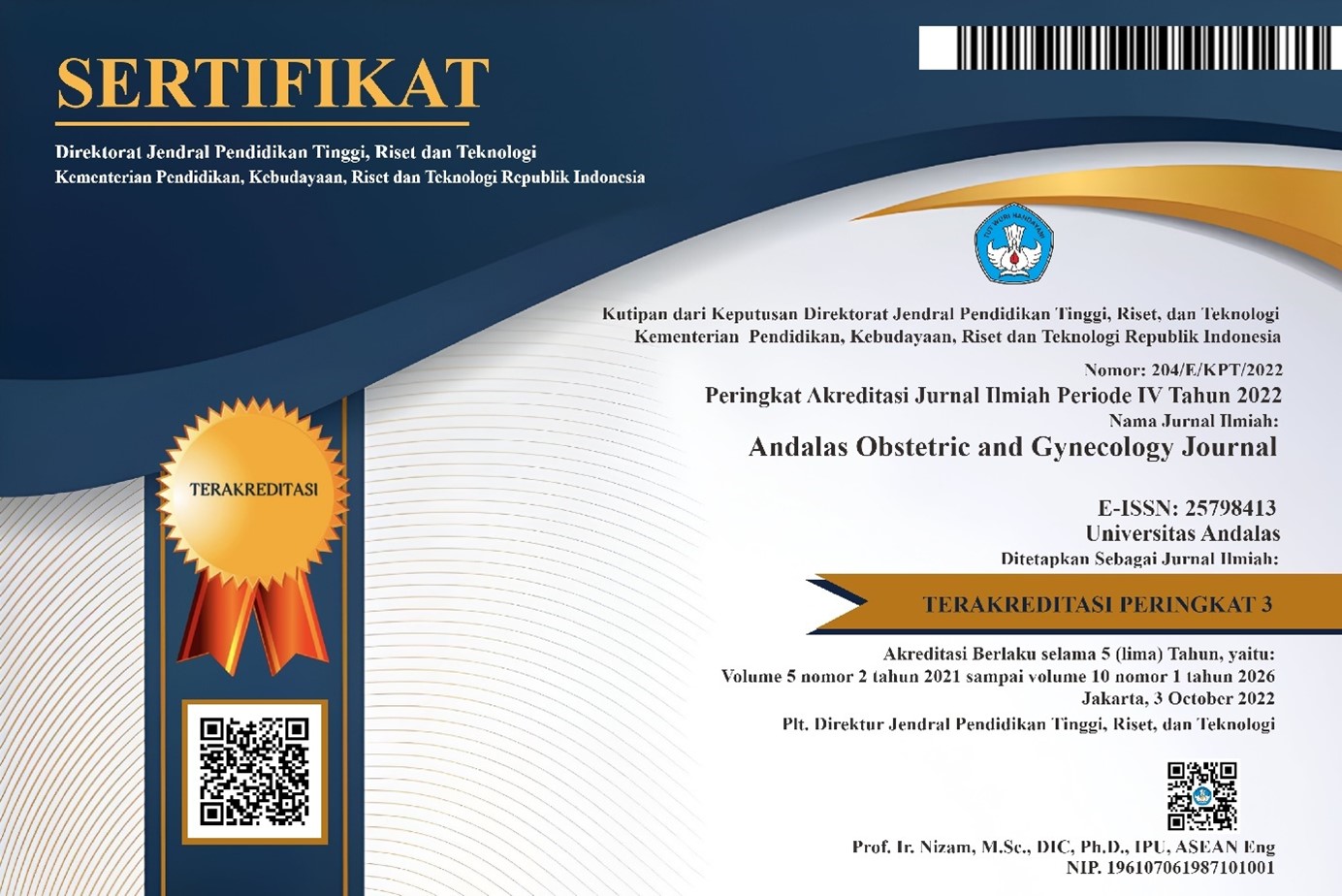Perimortem Cesarean Section : As Resucitative Hysterotomy On Maternal Cardiac Arrest
DOI:
https://doi.org/10.25077/aoj.4.2.218-230.2020Abstract
Maternal cardiac arrest or maternal collaps is defined as an acute event involving the cardiorespiratory systems and/or brain, resulting in a reduced or absent consciousness level (and potentially death), at any stage in pregnancy and up to six weeks after delivery. Perimortem Cesarean Section (PCS) is performed either during maternal cardiac arrest or during impending maternal cardiac arrest toresuscitate mother and fetal. Current recommendations for maternal resuscitation include performance of the procedure following five minutes of unsuccessful cardiopulmonary resuscitation. The most common aetiology of maternal collaps was know as “4 H and 4 T†(Hypovolemia, Hypoxia, Hypo/Hyperkalemia,Hypothermia; Tromboembolism, Toxicity, Tension pneumothorax, Tamponade). Resuscitation in maternal cardiac arrest is mostly similar with non-pregnant patient resuscitation. There are several considerations need to be addressed in primary survey such as endotracheal tube 1 size smaller, supplemental O2 regardless of peripheral saturation, aggressive volume resuscitation, and uterine displacement to relieve compression of the IVC.
Keywords: Maternal cardiac arrest; non-pregnant patient resuscitation
References
Ayu, Rully, Yuyun Lisnawati. Perimortem C-section : The Importance of 4 minutes Rule.2015. Indonesia university journal; Vol 3 No.3
Elkady, Adel. Peri-Mortem Cesarean Section : a Literature Review and Comprehensive Overview. 2015. Enliven Gynecology Obstetry: 2(2);005
Yates, Elizabeth, Richard. Emergency Management Maternal Cardiac Arrest and Maternal Collapse. 2020. Update in Anaesthesia.doi: 10.1029/WFSA-D
Boyd, Allie.Peri-Mortem C-Section.2016. core em
Gatti, Francesca, Marco Spagnoli, Simone Maria, Dario Colombo, Mario Landriscina. Out-of-hospital Perimortem Cesarean Section as Resuscitative Hysterotomy in Maternal Post Traumatic Cardiac Arrest. 2014. Hindawi Pub: Vol 2014, 4 pg
Royal College of Obstetriciant and Gynecologist. Maternal Collapse in pregnancy and puerpurium. 2016.http//www.rcog.org.uk/guideline
Lanoix, Richard, Vijay Akkapedi, Bruce Godfather. Perimortem Cesarean Section: Case Reports and Recommendation.2015. Willay lab: Vol 2, Issue12
Vanden Hoek TL, Morrison LJ, Shuster M, et al. Part 12: cardiac arrest in special situations: 2010 American Heart Association Guidelines for Cardiopulmonary Resuscitation and Emergency Cardiovascular Care. Circulation. 2010;122(18 Suppl 3):S829. PMID20956228
Rodriguez. PErimortem Cesarean Section of Twin Pregnancy; Case Report and Review of Literature. 2000. Acad Emerg Med
Chung-yan Lee, Shu-wing Kung. Perimortem caesarean section: A case report of an out-of-hospital arrest pregnant woman.2018. World J Emerg Med 2018;9(1):70–72 DOI: 10.5847/wjem.j.1920–8642.2018.01.012
Downloads
Published
Issue
Section
License
Copyright (c) 2020 JOURNAL OBGIN EMAS

This work is licensed under a Creative Commons Attribution 4.0 International License.
Copyright
Authors who publish with this journal agree to the following terms:
- Authors retain the copyright of published articles and grant the journal right of first publication with the work simultaneously licensed under a Creative Commons Attribution 4.0 International License that allows others to share the work with an acknowledgment of the work's authorship and initial publication in this journal.
- Authors are able to enter into separate, additional contractual arrangements for the non-exclusive distribution of the journal's published version of the work (e.g., post it to an institutional repository or publish it in a book), with an acknowledgment of its initial publication in this journal.
- Authors are permitted and encouraged to post their work online (e.g., in institutional repositories or on their website) prior to and during the submission process, as it can lead to productive exchanges, as well as earlier and greater citation of published work (See The Effect of Open Access).
License:
Andalas Obstetrics and Gynecology Journal (AOJ) is published under the terms of the Creative Commons Attribution 4.0 International License. This license permits anyone to copy and redistribute this material in any form or format, compose, modify, and make derivatives of this material for any purpose, including commercial purposes, as long as they credit the author for the original work.







